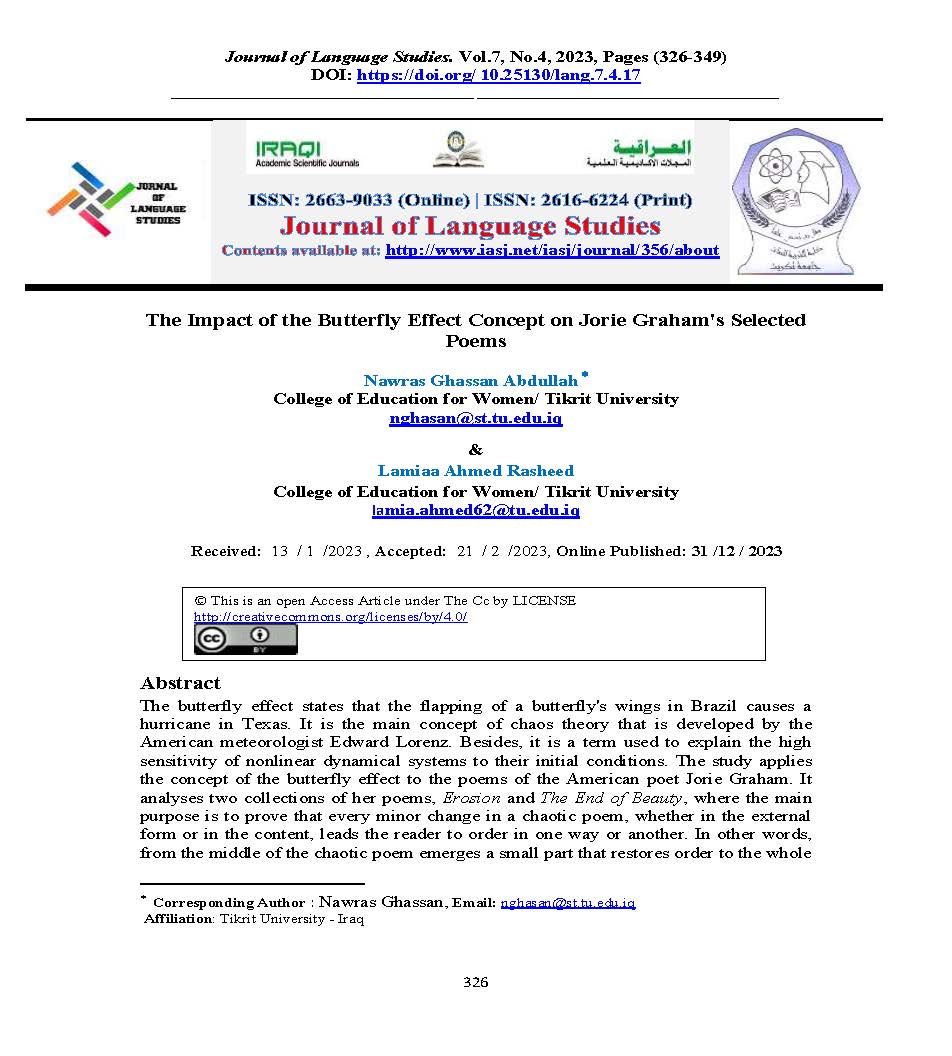The Impact of the Butterfly Effect Concept on Jorie Graham's Selected Poems
DOI:
https://doi.org/10.25130/lang.7.4.17Keywords:
butterfly effect, The End of Beauty, ErosionAbstract
The butterfly effect states that the flapping of a butterfly's wings in Brazil causes a hurricane in Texas. It is the main concept of chaos theory that is developed by the American meteorologist Edward Lorenz. Besides, it is a term used to explain the high sensitivity of nonlinear dynamical systems to their initial conditions. The study applies the concept of the butterfly effect to the poems of the American poet Jorie Graham. It analyses two collections of her poems, Erosion and The End of Beauty, where the main purpose is to prove that every minor change in a chaotic poem, whether in the external form or in the content, leads the reader to order in one way or another. In other words, from the middle of the chaotic poem emerges a small part that restores order to the whole poem. The poet’s seemingly disordered techniques employed in her poems are strategically used to create the sense of order in the middle of chaos.
References
Alghamdi, Mariam Ahmad M. (2018). I Think I Feel My Thinking-Self and How it Stands': Self and Cognitive Identity in the Poetry of Jorie Graham. University of Southampton Research Repository.
Casper, Robert N. (2001). About Jorie Graham: A Profile. Ploughshares at Emerson College. Retrieved from: https://www.pshares.org/issues/winter-2001-02/about-jorie-graham-profile
Chiasson, Dan. (2015, 23March). Beautiful Lies: The Poetry of Jorie Graham. The New Yorker. Retrieved from: https://www.newyorker.com/magazine/2015/03/30/beautiful-lies
Costello, Bonnie. (1992). Art and Erosion. University of Wisconsin Press. Contemporary Literature, Vol.33, No.2, P.373-395. Retrieved from: http://www.jstor.org/stable/1208675
Deaton, Jeremy. (2020, 2Feb.). The Butterfly Effect is not What you Think it is. The Washington Post. Retrieved from: https://www.washingtonpost.com/weather/2020/02/02/butterfly-effect-is-not-what-you-think-it-is/
Dizikes, Peter. (2008). The Meaning of the Butterfly. Globe Newspaper Company. Retrieved from: http://archive.boston.com/bostonglobe/ideas/articles/2008/06/08/the_meaning_of_the_butterfly/?page=full
Dooley, Kevin J. (2009). The Butterfly Effect of the "Butterfly Effect". Research Gate. Retrieved from: https://www.researchgate.net/publication/26293156_The_Butterfly_Effect_of_the_Butterfly_Effect
Ercetin, Sefika Sule & Potas, Nihan. (2019). Chaos, Complexity and Leadership 2017. Springer International Publishing AG.
Graham, Jorie. (1983). Erosion. Princeton University Press.
Graham, Jorie. (1987). The End of Beauty. New York: The Ecco Press.
Hayles, N. Katherine. (1990). Chaos Bound: 'Orderly Disorder in Contemporary Literature and Science. Cornell University Press.
Henderson, Julianne. (2017). Negotiating the Space Between Order and Chaos in Poetry. ResearchGate. Retrieved from: http://www.researchgate.net/publication/329104235
Jarman, Mark. (1992). The Grammar of Glamour: The Poetry of Jorie Graham. New England Review. Vol.14, No.4. Retrieved from: http://www.jstor.org/stable/40242559
Karagueuzian, Catherine Sona. (2005). No Image There and the Gaze Remains. Routledge Tylor & Francis Group New York London.
Leblond, Claire Majola. (2015). The Butterfly Effeect in Alice Munro's "Day of the Butterfly". Chaos, Empathy and the End of Certainty. Retrieved from: https://journals.openedition.org/esa/923?lang=en
Leubner, Ben. (2009). Bedrock, Erosion, and Form: Jorie Graham and Wittgenstein. Twentieth Century Literature, Vol.55, No.1, pp.36-57. Retrieved from: http://www.jstor.org/stable/40599963
Lorenz, Edward N. (1993). The Essence of Chaos. University of Washington Press.
Lussier's, Bardon. (2023). Understanding Jorie Graham. The California Journal of Poetics. Retrieved from: http://www.californiapoetics.org/criticism/994/understanding-jorie-graham/
Selby, Nick. (2012, 1Jun). Open ground: American mythologies and Jorie Graham's 'Pollock and Canvas'. Word & Image: A Journal of Verbal/Visual Enquiry. Retrieved from: http://dx.doi.org/10.1080/02666286.2006.10435741
Shifrer, Anne. (1995). Iconoclasm in the Poetry of Jorie Graham. Colby Quarterly, Vol.31, No.2, P.142-153. Retrieved from: https://digitalcommons.colby.edu/cq
Spiegelman, Willard. (1998). Jorie Graham's "New Way of Looking". Salmagundi, No.120, pp. 244-275. Skidmore College. Retrieved from: http://www.jstor.org/stable/40549078
Taylor, Laurel. (2000). Comparison as the Gesture Between Them: John Burnside and Jorie Graham. Postgraduate English. Issue02. University of St. Andrews. Retrieved from: www.dur.ac.uk/postgraduate.english

Downloads
Published
Versions
- 2023-12-31 (2)
- 2023-12-31 (1)
